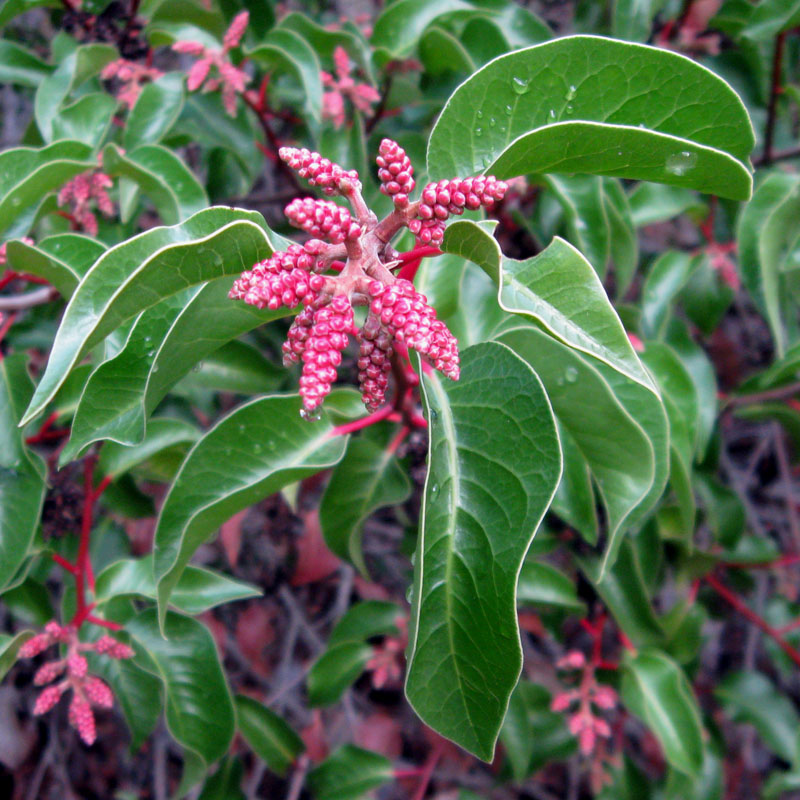
There are a number of views in the back-country towards the mountains and high deserts of southern California or even the mountains and high country of Arizona/New Mexico where you might see this often ignored and taken for granted beautiful chaparral community which when all other shrubs seem drought dormant and rangy looking, this one stands out as a rich shiny waxy green bush with taco shelled shaped leaves. Take a look at some common shots you may now recognize but have ignored in the past as you sped by down the road no doubt on your way to 'Party Hardy Marty' at 'Blow-Sand' in Ocotillo Wells, 'Glamis Sand Dunes' or onto 'Martinez Lake' at the Colorado River near Yuma, AZ.
 |
| photos: Lee Dittman |
Here's it most common distribution
Like many natives, this one has interesting colours and ornamental value as far as variety of colours and growth as the year progresses. Here are what it looks like before bud break or bloom.
Here it is in flowers which are finally in bloom.
And finally here it is with fruits or seeds. For those familiar with it, it should remind you of the Lemonade Berry Seeds which is a related cousin.
As another one of those important qualities, this is yet another shrub that will spring back from a brush fire. Many non-native ornamental plantings will not do this. You have to go purchase more planting stock and that will take more than twice as long to rebuild what has been lost in the landscape.
 |
| Photo by mjplagens |
So exactly what can a gardener/Landscaper do with a Sugar Sumac (Rhus ovata) ? First let's take the formal shrub replacement ideas. Here's what Tree of Life Nursery suggests.
EXCELLENT SUBSTITUTE FOR:
Ligustrum
Myoporum
Oleander
Photinia
Pittosporum
Raphiolepis
Xylosma
For the moment I'll just deal with Oleander Bush and reasons for Rhus ovata as it's replacement. In Southern California these were very common along the Interstates as landscaping screens and most often it was easily viewed in the median as an oncoming head lights barrier screen. Unfortunately something happened to them in the way of a slow death cause by some blight. This shrub and many other chaparral species should be considered a good replacement for other non-natives for just such a common utility function because once established and especially with a mycorrhizal grid intact, such plantings should become drought resistant or at least tolerant with less water if any at all becoming unnecessary. This of course changes with regards to location. In the deserts southwest in the USA, you most likely will have to deeply water at least once a month or possibly every two weeks depending on the location and circumstances. Even where I have seen it on the desert floor in a wash around Anza Borrego State Park, there was permanent water under the sand. Nevertheless it's an important planning point in view of the high cost of water and even it's future availability to the southwest. Many folks will want a formal look, maybe even having one as a specimen shrub or small tree and that's fine.
However my personal choice is creating more natural settings or themes out in the landscape. Today there are numerous newer housing or Condo developments which through structuring smaller landscapes has given themselves far more profit than those homes built in the 1950s with the large lots for large family backyard designing. Hence many small yards won't take large trees. In some cases the yards are just to narrow. Over here in Europe, small tiny cramped backyards are common, but worse than that is having towering apartment buildings and nosey neighbours seeing your every move in the garden, absolutely no privacy. Even when I was a landscaper in Southern California some of our properties were Mobile Home Parks with very little room for larger trees and shrubs.
My next post will detail my experiences growing up in coastal chaparral country and how this unique world and exploring it's dry washes and stream beds or climbing rock knoll outcroppings on hill tops with trees as a kid gave miniature woodlands of dwarfed chaparral me later on in life some insight on the landscape possibilities of the chaparral which has inspired in me with creative ideas on replicating some of the tiny hidden world environments for small spaces called "Elfin Forests" or "Pigmy forests".
 | |
| Texas Madrone (Arbutus xalapensis) |
Guadalupe Mountains
For a further take or perspective on Sugar Sumac or Sugarbush Rhus ovata and it's uses, please see the blog entry by Landscape Professional David Cristiani of Albuquerque's Quercus Group at
http://desertedge.blogspot.se/2011/02/deceptively-lush.html







